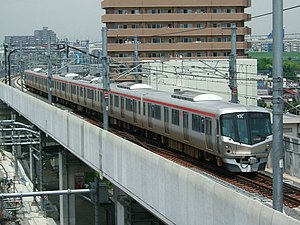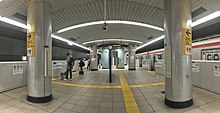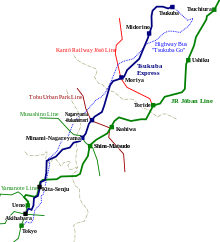Tsukuba Express
| Tsukuba Express | |
|---|---|
 A Tsukuba Express train (TX-2000 series) | |
| Overview | |
| Native name | つくばエクスプレス |
| Status | In operation |
| Owner | Metropolitan Intercity Railway Company |
| Locale | Kanto Region |
| Termini | |
| Stations | 20 |
| Service | |
| Type | Commuter rail |
| Operator(s) | Metropolitan Intercity Railway Company |
| Depot(s) | Moriya |
| Rolling stock | TX-1000 series / TX-2000 series / TX-3000 series |
| Daily ridership | 431,060 (daily 2015)[1] |
| History | |
| Opened | 24 August 2005 |
| Technical | |
| Line length | 58.3 km (36.2 mi) |
| Character | Urban |
| Track gauge | 1,067 mm (3 ft 6 in) |
| Electrification | 1,500 V DC overhead catenary (Akihabara–Moriya) 20 kV AC, 50 Hz (Moriya–Tsukuba) |
| Operating speed | 130 km/h (81 mph) |
Tsukuba Express | ||||||||||||||||||||||||||||||||||||||||||||||||||||||||||||||||||||||||||||||||||||||||||||||||||||||||||||||||||||||||||||||||||||||||||||||||||||||||||||||||||||||||||||||||||||||||||||||||||||||||||||||||||||||||||||||||||||||||||||||||||||||||||||||||||||||||||||||||||||||||||||||||||||||||||||||||||||||||||||||||||||
|---|---|---|---|---|---|---|---|---|---|---|---|---|---|---|---|---|---|---|---|---|---|---|---|---|---|---|---|---|---|---|---|---|---|---|---|---|---|---|---|---|---|---|---|---|---|---|---|---|---|---|---|---|---|---|---|---|---|---|---|---|---|---|---|---|---|---|---|---|---|---|---|---|---|---|---|---|---|---|---|---|---|---|---|---|---|---|---|---|---|---|---|---|---|---|---|---|---|---|---|---|---|---|---|---|---|---|---|---|---|---|---|---|---|---|---|---|---|---|---|---|---|---|---|---|---|---|---|---|---|---|---|---|---|---|---|---|---|---|---|---|---|---|---|---|---|---|---|---|---|---|---|---|---|---|---|---|---|---|---|---|---|---|---|---|---|---|---|---|---|---|---|---|---|---|---|---|---|---|---|---|---|---|---|---|---|---|---|---|---|---|---|---|---|---|---|---|---|---|---|---|---|---|---|---|---|---|---|---|---|---|---|---|---|---|---|---|---|---|---|---|---|---|---|---|---|---|---|---|---|---|---|---|---|---|---|---|---|---|---|---|---|---|---|---|---|---|---|---|---|---|---|---|---|---|---|---|---|---|---|---|---|---|---|---|---|---|---|---|---|---|---|---|---|---|---|---|---|---|---|---|---|---|---|---|---|---|---|---|---|---|---|---|---|---|---|---|---|---|---|---|---|---|---|---|---|---|---|---|---|---|---|---|---|---|---|---|---|---|---|---|---|---|---|---|
Station stops | ||||||||||||||||||||||||||||||||||||||||||||||||||||||||||||||||||||||||||||||||||||||||||||||||||||||||||||||||||||||||||||||||||||||||||||||||||||||||||||||||||||||||||||||||||||||||||||||||||||||||||||||||||||||||||||||||||||||||||||||||||||||||||||||||||||||||||||||||||||||||||||||||||||||||||||||||||||||||||||||||||||
| ||||||||||||||||||||||||||||||||||||||||||||||||||||||||||||||||||||||||||||||||||||||||||||||||||||||||||||||||||||||||||||||||||||||||||||||||||||||||||||||||||||||||||||||||||||||||||||||||||||||||||||||||||||||||||||||||||||||||||||||||||||||||||||||||||||||||||||||||||||||||||||||||||||||||||||||||||||||||||||||||||||
| ||||||||||||||||||||||||||||||||||||||||||||||||||||||||||||||||||||||||||||||||||||||||||||||||||||||||||||||||||||||||||||||||||||||||||||||||||||||||||||||||||||||||||||||||||||||||||||||||||||||||||||||||||||||||||||||||||||||||||||||||||||||||||||||||||||||||||||||||||||||||||||||||||||||||||||||||||||||||||||||||||||

The Tsukuba Express (つくばエクスプレス, Tsukuba Ekusupuresu), or TX, is a Japanese railway line operated by the third-sector company Metropolitan Intercity Railway Company, which links Akihabara Station in Chiyoda, Tokyo and Tsukuba Station in Tsukuba, Ibaraki. The route was inaugurated on 24 August 2005.[2]
History
[edit]
The Metropolitan Intercity Railway Company (首都圏新都市鉄道株式会社, Shuto-ken Shin Toshi Tetsudō Kabushiki-gaisha) was founded on 15 March 1991 to construct the Tsukuba Express, which was then provisionally called the Jōban New Line (常磐新線, Jōban Shinsen). The new line was planned to relieve crowding on the Jōban Line operated by East Japan Railway Company (JR East), which had reached the limit of its capacity. However, with the economic downturn in Japan, the goal shifted to development along the line. This was facilitated by the enactment of the Special Measures Law in September 1989 which allowed the expedition of large housing projects as well as the expansion and construction of new and existing railway lines.[2]
During the early stages of construction, the construction company (Japan Railway Construction, Transport and Technology Agency, or JRTT) as well as associated keiretsu and associates in the public sector purchased land situated on the alignment of the route. Eventually, all the lots would be joined continuously, completed or not, and their ownership transferred to the eventual railway operator, MIRC.[2] Construction of all stations were centered around the theme of universal design.[2]
Also, the initial plan called for a line from Tokyo Station to Moriya, but expenses forced the planners to start the line at Akihabara instead of Tokyo Station, and pressure from the government of Ibaraki Prefecture resulted in moving the extension from Moriya to Tsukuba into Phase I of the construction.
The original schedule called for the line to begin operating in 2000, but delays in construction pushed the opening date to summer 2005. The line eventually opened on 24 August 2005.[3]
From the start of the revised timetable on 15 October 2012, new "Commuter rapid" (通勤快速, tsūkin kaisoku) services were introduced in the morning (inbound services) and evening (outbound services) peak periods.[4]
Future plans
[edit]In September 2013, a number of municipalities along the Tsukuba Express line in Ibaraki Prefecture submitted a proposal to complete the extension of the line to Tokyo Station at the same time as a new airport-to-airport line proposed as part of infrastructure improvements for the 2020 Summer Olympics.[5]
On 31 March 2023, four proposals for possible northern extensions were submitted to Ibaraki Prefecture governor Kazuhiko Ōigawa.[6] The proposals included plans to extend the line to either:
- Tsuchiura Station on the Joban Line
- Ibaraki Airport
- Mito (via Ishioka Station) on the Joban Line
- Mount Tsukuba
According to the proposals, the plan for the extension to Tsuchiura Station produced the most favourable cost-benefit analysis.
Driving
[edit]The Tsukuba Express is operated as a one-man (conductorless) train. The driver opens and closes the doors manually, but operation of the train is done automatically. The line has a top speed of 130 km/h (81 mph). The Rapid service reduced the time required for the trip from Akihabara to Tsukuba from the previous 1 hour 30 minutes (by the Jōban Line, arriving in Tsuchiura, about 15 km (9.3 mi) from Tsukuba) or 70 minutes (by bus, under optimal traffic conditions) to 45 minutes. From Tokyo, the trip takes 50–55 minutes. The line features no level crossings.
Electrification and rolling stock
[edit]To prevent interference with the geomagnetic measurements of the Japan Meteorological Agency at its laboratory in Ishioka, the portion of the line from Moriya to Tsukuba operates on alternating current. As a result, three train models are used on the line; TX-1000 series DC-only trains, which can operate only between Akihabara and Moriya, TX-2000 series and TX-3000 series dual-voltage AC/DC trains, both of which can operate over the entire line.[7]
Volume production of the line's initial rolling stock began in January 2004, following the completion in March 2003 of two (TX-1000 and TX-2000 series) six-car trains for trial operation and training. The full fleet of 84 TX-1000s (14 six-car trains) and 96 TX-2000s (16 six-car trains) was delivered by January 2005. New TX-3000 series trains built by Hitachi Rail entered service on 14 March 2020.
Operation
[edit]Metropolitan Intercity Railway Company offers four types of train services on the Tsukuba Express:
- : Local (普通, Futsū)
- : Semi Rapid (区間快速, Kukan Kaisoku)
- : Commuter Rapid (通勤快速, Tsūkin Kaisoku)
- : Rapid (快速, Kaisoku)
Station list
[edit]Trains stop at stations marked "●" and skip stations marked "|".
During the morning rush hour on weekdays, Semi Rapid trains bound for Akihabara make an additional stop at Rokuchō (marked "▲").
| No. | Station name | Distance | Elec. | Local | Semi-Rapid | Commuter Rapid | Rapid | Transfers | Location | ||
|---|---|---|---|---|---|---|---|---|---|---|---|
| Japanese | English | Ward / City | Prefecture | ||||||||
| TX01 | 秋葉原 | Akihabara | 0.0 km (0 mi) | DC | ● | ● | ● | ● |
| Chiyoda | Tokyo |
| TX02 | 新御徒町 | Shin-Okachimachi | 1.6 km (0.99 mi) | ● | ● | ● | ● | Taitō | |||
| TX03 | 浅草 | Asakusa | 3.1 km (1.9 mi) | ● | ● | ● | ● | ||||
| TX04 | 南千住 | Minami-Senju | 5.6 km (3.5 mi) | ● | ● | ● | ● | JJ Joban Line (Rapid) | Arakawa | ||
| TX05 | 北千住 | Kita-Senju | 7.5 km (4.7 mi) | ● | ● | ● | ● |
| Adachi | ||
| TX06 | 青井 | Aoi | 10.6 km (6.6 mi) | ● | | | | | | | ||||
| TX07 | 六町 | Rokuchō | 12.0 km (7.5 mi) | ● | ▲ | ● | | | ||||
| TX08 | 八潮 | Yashio | 15.6 km (9.7 mi) | ● | ● | ● | ● | Yashio | Saitama | ||
| TX09 | 三郷中央 | Misato-chūō | 19.3 km (12.0 mi) | ● | ● | | | | | Misato | |||
| TX10 | 南流山 | Minami-Nagareyama | 22.1 km (13.7 mi) | ● | ● | ● | ● | JM Musashino Line | Nagareyama | Chiba | |
| TX11 | 流山セントラルパーク | Nagareyama-centralpark | 24.3 km (15.1 mi) | ● | | | | | | | ||||
| TX12 | 流山おおたかの森 | Nagareyama-ōtakanomori | 26.5 km (16.5 mi) | ● | ● | ● | ● | TD Tobu Urban Park Line | |||
| TX13 | 柏の葉キャンパス | Kashiwanoha-campus | 30.0 km (18.6 mi) | ● | ● | ● | | | Kashiwa | |||
| TX14 | 柏たなか | Kashiwa-Tanaka | 32.0 km (19.9 mi) | ● | | | | | | | ||||
| TX15 | 守谷 | Moriya | 37.7 km (23.4 mi) | ● | ● | ● | ● | ■ Jōsō Line | Moriya | Ibaraki | |
| TX16 | みらい平 | Miraidaira | 44.3 km (27.5 mi) | AC | ● | ● | | | | | Tsukubamirai | ||
| TX17 | みどりの | Midorino | 48.6 km (30.2 mi) | ● | ● | | | | | Tsukuba | |||
| TX18 | 万博記念公園 | Bampaku-kinenkōen | 51.8 km (32.2 mi) | ● | ● | | | | | ||||
| TX19 | 研究学園 | Kenkyū-gakuen | 55.6 km (34.5 mi) | ● | ● | ● | | | ||||
| TX20 | つくば | Tsukuba | 58.3 km (36.2 mi) | ● | ● | ● | ● | ||||
Ridership figures
[edit]| Fiscal year | Passengers carried (in millions) | Days operated | Passengers per day | Source |
|---|---|---|---|---|
| 2005 | 34.69 | 220 | 150,000 | [8] |
| 2006 | 70.69 | 365 | 195,000 | |
| 2007 | 84.85 | 366 | 234,000 | |
| 2008 | 93.21 | 365 | 258,000 | |
| 2009 | 97.79 | 365 | 270,300 | [9] |
| 2010 | 102.22 | 365 | 283,000 | [10] |
| 2011 | 104.89 | 366 | 290,000 | [11] |
| 2012 | 110.66 | 365 | 306,000 | [12] |
| 2013 | 118.22 | 365 | 323,900 | [13] |
| 2014 | 118.84 | 365 | 325,600 | [14] |
| 2015 | 124.14 | 365 | 340,100 | [15] |
| 2016 | 129.64 | 366 | 354,200 | [16] |
| 2017 | 135.12 | 365 | 370,200 | [17] |
| 2018 | 139.74 | 365 | 386,000 | [18] |
| 2019 | 143.10 | 365 | 395,000 | [19] |
| 2020 | 100.44 | 365 | 278,000 | [20] |
| 2021 | 110.61 | 365 | 306,000 | [21] |
See also
[edit]References
[edit]- ^ "平成27年 大都市交通センサス 首都圈報告書" (PDF). P.93. 国土交通省. Archived (PDF) from the original on 26 August 2018. Retrieved 29 September 2018.
- ^ a b c d Yamada, Kazunobu (December 2005). "Tsukuba Express – Introduction to Stations" (PDF). Japan Railway & Transport Review. 42: 50–59. Archived from the original (PDF) on 29 March 2017 – via East Japan Railway Culture Foundation.
- ^ "トピックス【TX情報】" [Topics (TX information)]. 首都圏新都市鉄道. 1 December 2005. Archived from the original on 1 December 2005. Retrieved 19 May 2020.
- ^ 10月15日(月)にダイヤ改正を実施いたします。 [15 October Timetable Revision]. News Release (in Japanese). Japan: Metropolitan Intercity Railway Company. 26 July 2012. Archived from the original on 30 July 2012. Retrieved 30 July 2012.
- ^ "TX東京駅延伸で茨城の沿線自治体市議会が意見書". 日本経済新聞. 21 September 2013. Archived from the original on 24 August 2021. Retrieved 24 September 2013.
- ^ "茨城県内のTX延伸先は「土浦方面」 県第三者委「実現可能性、採算性で優位」" [Proposals submitted for northern extension of the Tsukuba Express Line]. Sankei Shimbun DIGITAL (in Japanese). 31 March 2023. Retrieved 4 April 2023.
- ^ Barrow, Keith (12 June 2018). "Hitachi to supply extra trains for Tsukuba Express". railjournal.com. Simmons-Boardman Publishing. Archived from the original on 29 October 2019. Retrieved 29 October 2019.
- ^ "開業3周年を迎えるつくばエクスプレス(TX)" (Tsukuba Express Celebrates its 3rd Anniversary). Tetsudō Daiya Jōhō Magazine, August 2008 issue, p.63
- ^ 平成21年度 輸送実績のお知らせ [Transportation Figures for 2009] (PDF). News Release (in Japanese). Japan: Metropolitan Intercity Railway Company. 25 May 2010. Archived from the original (PDF) on 4 March 2016. Retrieved 28 November 2013.
- ^ 首都圏新都市鉄道(株)の平成22年度営業実績 [Business Performance of Metropolitan Intercity Railway Company for 2010] (PDF). News Release (in Japanese). Japan: Metropolitan Intercity Railway Company. 6 June 2011. Archived (PDF) from the original on 3 December 2013. Retrieved 28 November 2013.
- ^ 首都圏新都市鉄道(株)の平成23年度営業実績 [Business Performance of Metropolitan Intercity Railway Company for 2011] (PDF). News Release (in Japanese). Japan: Metropolitan Intercity Railway Company. 4 June 2012. Archived (PDF) from the original on 9 November 2013. Retrieved 28 November 2013.
- ^ 平成24年度営業実績 [Business Performance for 2012]. News Release (in Japanese). Japan: Metropolitan Intercity Railway Company. 7 June 2013. Archived from the original on 3 December 2013. Retrieved 28 November 2013.
- ^ 平成25年度営業実績 [Business Performance for 2013]. News Release (in Japanese). Japan: Metropolitan Intercity Railway Company. 6 June 2014. Archived from the original on 3 July 2014. Retrieved 8 November 2014.
- ^ 平成26年度営業実績 [Business Performance for 2014]. News Release (in Japanese). Japan: Metropolitan Intercity Railway Company. 2 June 2015. Archived from the original on 18 June 2015. Retrieved 2 June 2015.
- ^ 2015年度営業実績 [Business Performance for 2015]. News Release (in Japanese). Japan: Metropolitan Intercity Railway Company. 8 June 2016. Archived from the original on 15 August 2021. Retrieved 10 August 2021.
- ^ 2016年度営業実績 [Business Performance for 2016]. News Release (in Japanese). Japan: Metropolitan Intercity Railway Company. 1 June 2017. Archived from the original on 15 August 2021. Retrieved 10 August 2021.
- ^ 2017年度営業実績 [Business Performance for 2017]. News Release (in Japanese). Japan: Metropolitan Intercity Railway Company. 3 June 2018. Archived from the original on 15 August 2021. Retrieved 10 August 2021.
- ^ 2018年度営業実績 [Business Performance for 2018] (PDF). News Release (in Japanese). Japan: Metropolitan Intercity Railway Company. 3 June 2019. Retrieved 20 September 2022.
- ^ 2019年度営業実績 [Business Performance for 2019] (PDF). News Release (in Japanese). Japan: Metropolitan Intercity Railway Company. 6 June 2020. Retrieved 20 September 2022.
- ^ 2020年度営業実績 [Business Performance for 2020] (PDF). News Release (in Japanese). Japan: Metropolitan Intercity Railway Company. 3 June 2021. Retrieved 20 September 2022.
- ^ 2021年度営業実績 [Business Performance for 2021] (PDF). News Release (in Japanese). Japan: Metropolitan Intercity Railway Company. 3 June 2022. Retrieved 20 September 2022.


 French
French Deutsch
Deutsch